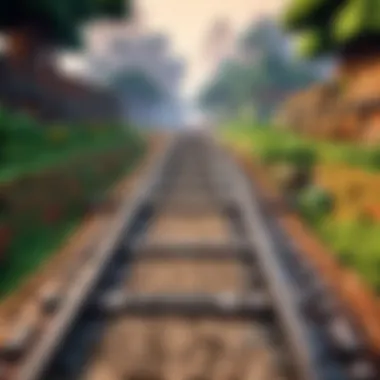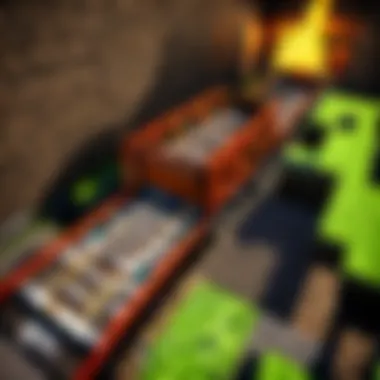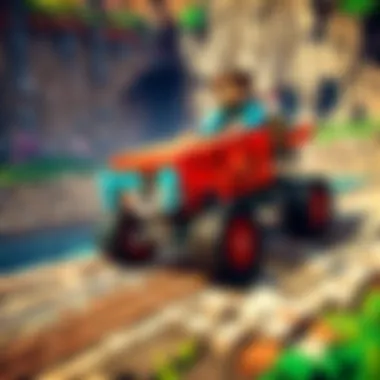Exploring the Intricacies of Minecart Gameplay in Minecraft


Intro
The minecart game in Minecraft offers more than just a way to traverse vast landscapes or haul items. It's a dynamic system that invites creativity and offers unique gameplay possibilities. This section aims to provide a foundational understanding of minecarts in Minecraft, setting the stage for further exploration into their mechanics and significance in the game.
As players delve into the world of Minecraft, they inevitably adopt a myriad of strategies to either enhance their gameplay or express their creativity. The versatility of minecarts plays an indispensable role in this dynamic, serving as a transport solution and as a canvas for engineering experiments. Moreover, it's vital for new players to grasp these functional aspects to appreciate the depth this game offers.
Reading through the following sections will enrich your understanding and skills associated with minecarts, ensuring you are well-equipped to maximize your gameplay experiences. Let’s begin our exploration of this integral component in Minecraft.
Minecraft Game Guides
Crafting a Minecart
Creating a minecart is simple. Players can produce one with just iron ingots and a furnace. Using the right combination of resources facilitates dynamic gameplay experiences.
Recipe:
- 5 Iron Ingots
- 1 Chest (optional for minecart storage)
This creates a basic minecart, capable of serving multiple utility purposes.
Building Tracks
The track's design influences how efficiently your minecart transports you from one point to another.
Essentials of Track Construction:
- Rails: Base requirement for tracks. Use iron ingots and sticks to craft.
- Powered Rails: Essential for activating and stopping minecarts. Crafted using gold, sticks, and redstone.
- Detector Rails:
Arranging tracks methodically can create exciting routes, optimizing transportation across your realm.
Redstone Mechanics Explained
Understanding Redstone control enhances your minecart systems significantly. Redstone can operate tracks and even automated minecart systems, be they for item transport or player commuting.
Consider experimenting with powered rails linked to redstone circuits, allowing for more functional and automated designs.
Crafting Redstone with minecarts may seem complicated initially but with practice, intricate constructions become possible.
Practical Strategies
Within the context of minecarts, several pragmatic strategies can help streamline gameplay. Employing strategies involves understanding both the game’s technical elements and the inherent limitations.
- Boosts: Combining powered rails with strategic placement allows for versatile hubs or direct routes to resources.
- Surveillance stations: Players can utilize minecarts with a rider to scout new territory efficiently.
Prelude to Minecarts in Minecraft
Understanding minecarts holds a significant place within the vast universe of Minecraft. As transportation tools, they enhance not only mobility but also strategic gameplay. Minecarts allow players to move resources efficiently and connect various structures. This facilitates exploration and speeds up construction projects. Players can build elaborate rail systems that fit their needs. The versatility of minecarts can simplify logistics in a world where players can create at their will.
However, their deployment requires some expertise. Players must understand mechanics related to power sources, tracks, and different types of carts. Grasping these elements sets the stage for both practical use and creative options. Minecarts epitomize the blend of utility and amusement that Minecraft is renowned for, appealing to enthusiasts of all experience levels.
Overview of Minecarts
Minecarts are one of the essential features in the world of Minecraft. They function as integral components in railroad transportation. Builders can craft three types of minecarts from different materials. The basic minecart offers simple travel along tracks. It can carry players or any entity needing mobility. Minecarts with extras, like chests or furnaces, add further practical functions. This allows for storage and automation.
The display of minecarts can be an aesthetic choice as well. Players often engage in exterior design, creating visually appealing rail systems in their settings. The construction of these tracks presents an opportunity to merge technical know-how with creative expression. Therefore, minecarts serve functional and artistic purposes within the game.
Historical Context of Minecarts
Minecarts made their debut early in the evolution of Minecraft. They quickly gained popularity due to their simplicity. Originally introduced with single functions, such as player transport, they received continual upgrades. Over the years, developers incorporated features allowing carts to interact more meaningfully with the game environment. Updates during the introduction of redstone created new possibilities for automation. Players became captivated with their capacity to revolutionize transportation and logistical systems in their worlds.
The reevaluation of minecarts corresponds to changes in player aspirations. As Minecraft grew, so did its community and the complex projects players sought to accomplish. Minecarts became vital instruments in resource farms, treasure hunts, and networking across vast terrains. Currently, they are iconic symbols of engineering prowess, demonstrating the player's ingenuity.
In summary, the examination of minecarts bridges basic and advanced gameplay in Minecraft. By understanding their past and overall purpose, players can appreciate how these carts hold enduring significance in both practical and creative realms.
Mechanics of Minecarts


The mechanics of minecarts play a crucial role in the broader discussion of the gameplay in Minecraft. Understanding these elements will deepen players' abilities to design complex systems, enhance their creative expression, and improve the efficiency of in-game tasks. This section delves into the functionalities that underpin minecart operations, examining their core components, energy sources, and behaviors. Each of these aspects significantly contributes to the overall utility and enjoyment found in using minecarts.
Basic Components and Functionality
Minecarts consist of simple yet vital components. The central element is, of course, the minecart itself. At a basic level, a standard minecart serves as a transport vessel within the game. Players can create it using a combination of iron ingots. Here is a breakdown of the basic components:
- Iron Ingot: The foundation of creating any minecart.
- Rail Tracks: Essential for guiding the minecart along a designated path.
- Cart Station Features: Items a player can link with minecarts, like hoppers or switches.
Minecarts operate on rail tracks, which players can customize in terms of layout and design. Different tracks can elevate, decline, or curve, which leads to more creative potential in routes. Without a proper understanding of how these components work together, one may face issues like derailing or inefficient transportation.
Energy Sources and Propulsion
Propulsion is an integral part of successfully using minecarts. There are various methods through which players can generate movement:
- Powered Rails: When redstone is applied, these tracks provide an essential thrust for minecarts, accelerating them faster than regular rails. Powered rails are a fundamental aspect of elevating transportation efficiency in Minecraft.
- Furnace Minecarts: Using coal or other combustible materials, players can create furnace minecarts which pull regular minecarts behind them. This unique feature adds another layer of complexity to minecart systems.
- Passenger Dynamics: The presence of players or specific mobs can also propel the cart forward. This fact emphasizes strategy over simple execution within the game's mechanics.
When using minecarts, it is essential to consider optimal combinations of propulsion methods, as well as specific applications based on the intended route and frequency of travel required. Balancing these elements will maximize the effectiveness of any minecart system.
Cart Behaviors and Physics
Minecarts exhibit behaviors shaped by Minecraft's underlying physics engine. Their movement can feel intuitive, but understanding how these behaviors work reinforces strategic planning.
Important factors influencing minecart behavior include:
- Inertia: Once set in motion, minecarts tend to continue until a barrier or a track modification redirect them. This allows for designing longer, uninterrupted routes.
- Gravity and Inclines: Minecarts will accelerate down gradients but slow down on inclines. Strategic planning of track elevation can affect transportation speeds, which necessitates intelligent design choices.
- Interactions with Other Entities: When minecarts collide with obstacles or each other, the result can lead not only to exhilarating gameplay but also to potential cart jams. This necessitates mindful builds and consideration about how many carts to use in a given area.
Proper understanding of the physics behind minecarts leads to greater control over transportation efficiency.
Mastering these mechanics allows players to utilize minecarts effectively. Whether it’s for personal transport, resource movement, or creating advanced automated systems, comprehensive knowledge of minecart mechanics is essential in the Minecraft landscape.
Types of Minecarts
Minecarts play a pivotal role in an array of gameplay mechanics in Minecraft. Understanding the different types of minecarts is essential for players seeking to maximize their use effectively. Each variant brings unique capabilities and functions, providing players with the capacity to manage resources, create functional transport systems, and enhance exploration experiences. As players engage with these different types, they uncover a vast realm of possibilities that scale across efficiency and creativity.
Standard Minecart
The standard minecart serves as the most fundamental version available in the game. Crafted from iron ingots, its significance lies in its simple use for traversing rail tracks. Whether navigating between distant bases or exploring vast landscapes, the standard minecart embodies ease of transportation. It moves on powered tracks when propelled by various energy sources, offering a straightforward conveyance option for both new and seasoned players.
Utilizing this type allows players to effectively manage their in-game time, moving swiftly across regions, especially in survival mode where danger lurks in every corner. Leveraging the speed and simplicity of the standard minecart makes it a backbone of efficient movement.
Minecart with Chest
The minecart with chest serves a dual purpose—transportation and storage. Players can fill the chest with various items and ride alongside gasoline. As it rolls along the track, the operate can gather resources without needing to return to base constantly. This feature is especially useful for transporting items obtained during exploration, excavation, or crafting.
Players should consider optimal quantities and types of items to enhance their journeys. Though it lacks the speed of a focused freight train system, its utility in managing inventory is unparalleled. For efficient long-distance hauling, pairing this with powered rails is prudent.
Minecart with Furnace
The minecart with furnace introduces a novel capability—self-propulsion. Players can add fuel, such as coal or wood, to operate it autonomously along tracks. Such functionality grants flexibility in design, allowing for efficient long-distance travel without constant manual pushing. This is particularly beneficial in larger constructions or transport systems. By programming a series of rail switches or powered rails, players can optimize routes, making travel streamlined and effective.
However, fuel management remains vital. Players must consider both placement and fuel quantities to ensure continuous operation, especially over expansive environments.
Other Variants
Beyond the standard configurations, other minecart variants broaden functionality immensely. These include the minecart with Hopper and the minecart with TNT. Each variant possesses unique uses too. For example, the hoppers transfer items automatically, increasing logistical operations. Players can integrate it into automated storage systems, enhancing efficiency by streamlining item transfers directly in and out of chests.
The minecart with TNT is utilized primarily for combat or large-scale structures, allowing players to unleash explosions in strategic manners which could be incredibly effective against enemies or rug-level defence mechanisms.
Engaging with these diverse versions enlightens players to creativity. Whether crafting automated farms or developing clash systems, understanding each type can significantly enhance gameplay, addressing unique scenarios present in the infinite landscapes of Minecraft.
Building Efficient Minecart Systems
Building efficient minecart systems is crucial for optimizing transportation and logistics in Minecraft. Efficiency not only facilitates swift movement between extensive areas but also utilizes resources in a manner that saves time and energy. Properly designed minecart systems can significantly enhance gameplay, especially for players looking to transport materials or explore vast landscapes.
Track Layout Planning
Creating a well-thought-out track is instrumental in the overall efficiency of minecart systems. Players should prioritize clarity and directness in track layouts, reducing unnecessary loops and shortcuts that complicate travel.


Key considerations for effective track layouts:
- Direct Routes: Minimize unnecessary bends and avoid excessive length. Straight tracks lead to faster travel times.
- Elevation Changes: Understand how elevation affects speed. Place powered rails strategically to manage inclines effectively.
- Intersections: Define clear intersections to prevent confusion. Use signs or distinct markers to guide minecart users.
- Stations: Incorporate stations at strategic points for ease of access. This can enhance loading and unloading of resources significantly.
Investing time in planning a coherent track layout leads to smooth operations and an enjoyable gaming experience for all players.
Redstone Integration
Redstone is fundamental for creating sophisticated and responsive minecart systems. Integrating Redstone circuits allows players to automate various components, increasing the functionality of the systems.
Benefits of using Redstone with minecarts:
- Automated Loading: Use Redstone to create efficient loading mechanisms that activate minecarts upon receiving a signal. This minimizes manual unloading and improves resource transfer speed.
- Signal Control: Implement Redstone comparators and repeaters to control minecart stations more efficiently, ensuring minecarts depart only when conditions meet specific criteria.
- Timing Mechanisms: By arranging Redstone components, you can introduce timed operations that synchronize with other game functions, like events or activities in areas nearby.
With Redstone integration, the efficiency of minecart systems increases, thereby allowing for tailored solutions suited to personal gameplay styles.
Automating Minecart Systems
Automation is key to maximizing the potential of minecart systems. Automated systems reduce the manual intervention needed, allowing for seamless transportation of goods and enhancing overall gameplay experience.
Ways to achieve automation include:
- Redstone Tracks: Using powered rails linked to Redstone signals can create smooth, nonstop travel through longer routes.
- Mob Traffic Management: Incorporate mechanisms that respond to entities, permitting minecart systems to alter paths based on surrounding influences automatically.
- Block Breakers and Placers: Implement these blocks to manage the flow of items into or out of carts seamlessly, lessening the required physical maintenance.
Automated minecart systems not only simplify logistics but also free up significant player resources and time that can be redirected toward exploration or construction.
In summary, building efficient minecart systems in Minecraft can vastly improve gameplay, making the exploration and resource management more effective and enjoyable.
Strategic Use of Minecarts
The strategic use of minecarts plays a pivotal role in optimizing gameplay in Minecraft. These carts are not only a mode of transportation but also tools for creative and practical solutions to various challenges players face. Understanding how to effectively utilize minecarts can enhance efficiency, promote creativity, and sometimes even resolve complex logistical issues in a player's environment. In this section, we will discuss the significance of minecarts concerning resource transportation, creating fast travel options, and their integration in combat and exploration aspects of the game.
Resource Transportation
Efficiently moving resources in Minecraft can be tedious, especially in larger builds or extensive mining operations. This is where minecarts excel. Minecarts with chests allow players to transport multiple items across great distances without the need for overly complex manual transport systems. The minecart with chest enables players to store their collected resources in one unit and cart them to storage facilities or crafting areas.
Benefits:
- Efficiency: Players can move stacks of items quickly.
- Creativity: The incorporation of minecarts can streamline resource flow in your build..
- Simplicity: Minecarts reduce the physical labor involved in transporting items, make it an easier experience.
In mob arenas or established farms, minecarts can also retrieve items, collect drops, and transfer everything back to a desired location. Using several minecarts in tandem can create an effective automatic inventory-moving system that saves time and effort.
Creating Fast Travel Options
As the virtual world of Minecraft can be vast, fast travel methods become essential. Minecarts provide a practical avenue for creating transport routes, expediting travel times across long distances. Players can build tracks that subdivide different areas of their builds.
Considerations:
- Designing Efficient Tracks: Lay down continuous and broad paths seems key. Convex routes with gradual inclines aid cart navigation.
- Redstone Enhancements: Implementing powered rails at strategic points can propel minecarts faster, reducing travel duration substantially.
Aligning tracks with关键 rest stops or intersections can furnish players with rapid access to their mining workstations, farms, or construction sites.
Integrating Minecarts in Combat and Exploration
The utility of minecarts extends beyond just moving resources and crafting. Players can also use minecarts in combat scenarios or exploring their environments. For example, minecarts can serve as mobile platforms from which players can shoot arrows or use harmful potions without being in immediate danger while being secure inside the cart.
Potential Uses:
- Rapid Mobility: A minecart allows for movement during exploration, decreasing chances of encountering foes unprepared.
- Strategic Positioning: Sudden changes in position can confuse aggressive mobs.
Minecarts can also become an integral part of traps; positioning them cleverly sets up unexpected attacks to distant mobs. In contrast, placing track setups within substantial arenas offers unique trenches and travel patterns, adding depth to combat situations.
The strategic use of minecarts in Minecraft offers tremendous opportunities for players willing to invest time and creativity into learning these mechanics. Minecarts enhance functionality in diverse aspects of the game, from logistics to combat, illustrating the adaptable applications that these seemingly simple carts provide.
Common Issues and Solutions
Understanding the common issues and solutions related to minecarts in Minecraft is essential for enhancing gameplay. Minecarts add an exciting dynamic to the game, yet they come with unique challenges. Resolving these issues can significantly improve efficiency and player experience. By addressing cart jams, preventing cart destruction, and troubleshooting redstone connections, players can create seamless transit systems in Minecraft.


Dealing With Cart Jams
Cart jams happen when minecarts become stuck or collide on tracks. This pushes infuriating delays in transport systems. Knowing how to prevent these kinds of issues is key. Jams usually occur due to poor track design. A few pointers include:
- Smooth track layout: Ensure tracks have space and logical designs to promote smooth flow.
- Use detectors: Utilize tripwire hooks or powered rails to lessen collisions.
- Prioritize speed: Occasionally adjusting speeds helps with congestion.
By implementing these strategies, jsou can enhance minecart flow and efficiency while minimizing frustration.
Preventing Cart Destruction
Another common pitfall in minecart systems is cart destruction. Obstacles, explosions, or miscalculations can degrade functional carts. The problem usually arises from not comprehending the physics of minecarts adequately. Some strategies to prevent cart destruction include:
- Sensitive tracking: Minimize the occurrence of blocks that obstruct train paths by efficient track layout.
- Safety measures: Gear carts utilizing walls or barriers limits exposure to hostile factors.
- Regular checking: Inspect track systems, regularly removing potential hazards.
By taking these preventive actions, you reduce the likelihood of losing valuable carts.
Troubleshooting Redstone Connections
Redstone integration is crucial for automating minecarts but can lead to issues. Faulty connections hinder overall systems. To keep your redstone signaling working correctly, consider these methods:
- Transmitter checks: Ensure all components connect without issues considering distance.
- Avoid conflicts: Watch for block interference or incorrect placements that could cause slime glitches.
- Use comparators wisely: Utilize redstone repeaters effectively, especially for long distances.
Problems arising from improper redstone setup can complicate automated systems significantly. Observing these solutions will form a solid grounding for enjoyment of the game's features.
Proper design and awareness of minecart systems can lead to a remarkable gameplay experience, engaging players of varying skills.
Community and Cultural Impact of Minecart Gameplay
The role of minecarts within the Minecraft community extends beyond mere transportation; they embody a creative outlet that unites players. Engaging with minecarts catalyzes innovation, as players experiment with track layouts and integrate them into various aspects of gameplay. By studying the interplay between minecarts and community engagement, it is clear that this aspect contributes significantly to the game’s culture.
Fan Creations and Innovations
Fan-driven creations encompassing minecarts showcase the ingenuity prevalent in the Minecraft community. Players often design elaborate roller coasters and complex rail systems, blurring the lines between gameplay and artistic expression. Notable projects include the following:
- Massive Automated Transit Systems: Players have built extensive network of rails, creating automated transit systems operating without manual intervention.
- Themed Attractions: Some minecart creations aim for entertainment, featuring dramatic drops, twists, and turns reminiscent of amusement parks.
- Functional Builds: Beyond aesthetics, various designs emphasize utility, turning minecart tracks into vital transportation grids across vast worlds.
These projects often inspire others to think creatively and engage more deeply with the game. Furthermore, platforms such as Reddit serve as a hub where players showcase achievements, leading to shared recognition and widespread appreciation.
Minecart Challenges in Minecraft Communities
Despite the creative potential with minecarts, players face challenges that may hinder development and satisfaction. Issues often discussed in Minecraft communities include:
- Performance Limits: Large minecart systems can lead to lag, negatively impacting the fluidity of gameplay. Players regularly seek solutions to optimize performance while retaining design elements.
- Collision Problems: Cart traffic jams can occur, requiring specific track designs and regulations. The challenge thus remains to create efficient systems that minimize conflicts.
- Creative Constraints: Sometimes, players feel constrained by the logic and physics tied to minecart mechanics. This results in frustration, particularly for those wishing to push boundaries.
Collaborative discussions within forums like Facebook and dedicated subreddits assist in overcoming these obstacles. Sharing knowledge and solutions fosters community strength.
Ultimately, the impact of minecarts on Minecraft transcends gameplay mechanics, shaping a vibrant, collaborative culture for enthusiasts of all skill levels.
Ending
The conclusion of this article serves to encapsulate the vital role that minecarts play in Minecraft, not just as a mode of transportation but as a multifaceted element of gameplay innovation and strategy. Minecarts profoundly enhance the player experience. They allow for efficient resource transport, which can significantly speed up development in the game. Being aware of the protocols and structures surrounding minecart mechanics can elevate any player's building experience.
Summarizing the Role of Minecarts
Minecarts act as a pivotal feature within the Minecraft universe. They offer a versatile way to move items and players through various terrains. Understanding their mechanisms leads players to maximize their in-game potential. With the diverse types of minecarts available, such as standard or those adorned with chests, numerous tactical applications are possible.
Utilizing minecarts effectively can lead to optimized routes and more efficient resource management. Some of the notable roles they play in game strategy include:
- Automatic transport of materials, reducing time spent manually moving items.
- The setup of elaborate rail systems that support various gameplay styles, enhancing community projects or individual ambitions.
- Integration with Redstone devices boosts functionality, tying into larger in-game goals.
Minecarts are more than simple vehicles. They are foundational for creating complex systems in Minecraft.
Future Prospects for Minecart Innovations in Minecraft
The future holds numerous potentials for minecart systems in Minecraft. Players often discuss fresh updates or theories about what could improve current mechanisms. Developers can introduce additional types of minecarts or enhance existing ones to include features like better automation or magnetic properties to attune to player requirements.
Innovations could include:
- Mineshaft Railways that allow for deeper integration into the underground layers of Minecraft
- Advanced engine types that enable functionalities like speed control or braking with more intricate systems
- Enhanced monitoring systems via Redstone, promoting timing operations that minimize road clutter and maximize efficiency
With a vibrant community like Minecraft, these discussions foster creativity and collaboration. As players engage outh there Explorer spirit, who knows what other innovations will come forward? Ultimately, minecarts hold incredible importance in both gameplay and the shaping of community experiences.
The versatility of minecarts in Minecraft makes them essential tools for innovative players, changing how transportation and automated systems function within the game.



